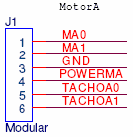Whats inside the NXT Brick: Part II
This is part two of Whats inside the NXT Brick series. Yesterday we took a look at the hardware specs and what makes the tick! In this article we will look at how the new motor ports and wiring system work...
The NXT Brick has three output motor ports on top of the brick for controlling the newly designed servo motors. To connect the servo to the NXT a 6-wire interface is used. This new six wire design allows the NXT to not only to control the servos but also for the servos to send information back to the NXT.
E ach of the six pins has a different task. The first two pins, MA0 and MA1, are output control signals that tell the
ach of the six pins has a different task. The first two pins, MA0 and MA1, are output control signals that tell the
The MA0 and MA1 output signals are controlled by an internal motor driver that supplies a continuous stream of 700 mA to each motor port. This can peak at a 1A max. The signals can me switched back and forth between float and brake. This means either your robot will coast freely when set to float, or will come to an immediate halt when set to brake. Most importantly though, the motor driver that controls these signals has built in thermal protection! This means that if for some crazy reason the NXT is pulling too much power for the servo, they will automatically limit the output current! Woohoo! No more fried motors!
The POWERMA pin is connected to the power outputs and can draw a maximum 180 mA. Really what this means is that when split up, each port can draw up to 20 mA. Another smart feature that the boys at lego thought of: if the port is drawing more than the 20 mA limit, the NXT will automatically reduce it back to 20 mA! Another safety feature is short circuited to the ground wire the NXT will automatically reset!
Finally, TACHOA pins carry the important task of reporting information back to the NXT. These two pins are also fitted with Schmitt triggers mounted between the ports and the processor. When you first take your NXT out of the box and have the standard firmware, these two signals are preset to work as rotation sensors for the motors and to check which way the motors are running.
Another great feature of the new NXT six-wire interface is the backwards compatability. The NXT wires are designed in a way that they can be spliced in a way to connect to the old RIS RCX! Philo has done some great work on showing how this can be done in his Custom NXT Cables Tutorial.
That's all for this part, check out the next article for a look at the sensor input system!
P.S. Be sure to go check out LEGO's Hardware Developer Kit!
No comments:
Post a Comment